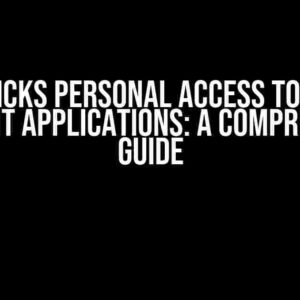As a system administrator, managing file transfers and access to your servers is a critical task. One of the most secure ways to do this is by using SFTP (Secure File Transfer Protocol) and creating an SFTP admin user. In this comprehensive guide, we’ll take you through the process of creating and managing an SFTP admin user, covering the benefits, steps, and best practices to ensure maximum security and efficiency.
What is SFTP and Why Do You Need an Admin User?
SFTP is a secure protocol used for transferring files over a network, typically used for accessing, managing, and maintaining files on a remote server. Unlike FTP (File Transfer Protocol), SFTP encrypts both the authentication process and the data transferred, making it a more secure option.
An SFTP admin user is a user account with elevated privileges that allows you to manage and control access to your SFTP server. This user account is essential for:
- Managing user accounts and permissions
- Configuring server settings and protocols
- Monitoring system logs and security
- Performing administrative tasks, such as updating software and running maintenance scripts
Benefits of Creating an SFTP Admin User
Creating an SFTP admin user offers several benefits, including:
- Enhanced Security: By creating a separate admin user, you can limit access to sensitive areas of your server and reduce the risk of unauthorized access or data breaches.
- Improved Management: With an admin user, you can delegate tasks and manage access to your SFTP server more efficiently, reducing the workload and improving productivity.
- Better Auditing and Logging: An admin user allows you to track and monitor system changes, making it easier to identify and resolve issues, and maintain compliance with regulatory requirements.
Step-by-Step Guide to Creating an SFTP Admin User
Creating an SFTP admin user is a straightforward process that can be completed in a few steps:
Step 1: Create a New User Account
Open your SSH client (e.g., PuTTY on Windows or Terminal on macOS/Linux) and connect to your SFTP server using your existing admin credentials.
ssh root@your-sftp-server_IP_addressCreate a new user account using the following command:
useradd sftpadminStep 2: Set a Strong Password
Set a strong and unique password for the new user account:
passwd sftpadminStep 3: Grant Administrative Privileges
Grant the new user account administrative privileges using the following command:
usermod -aG sudo sftpadminStep 4: Configure SFTP Settings
Configure the SFTP settings to allow the new admin user to access the server:
sudo nano /etc/ssh/sshd_configAdd the following lines to the end of the file:
Match User sftpadmin
ForceCommand internal-sftp
ChrootDirectory /home/sftpadmin
Save and exit the file. Restart the SSH service to apply the changes:
sudo service ssh restartManaging Your SFTP Admin User
Now that you’ve created an SFTP admin user, it’s essential to manage and maintain this account to ensure maximum security and efficiency:
Managing User Permissions
Assign permissions to the SFTP admin user using the following command:
sudo chown -R sftpadmin:sftpadmin /home/sftpadminThis sets the ownership of the /home/sftpadmin directory to the SFTP admin user.
Monitoring System Logs
Regularly monitor system logs to detect any suspicious activity or potential security breaches:
sudo journalctl -u sshd | grep sftpadminThis command displays the system logs related to the SFTP admin user.
Updating Software and Running Maintenance Scripts
Schedule regular maintenance tasks, such as software updates and backups, to ensure your SFTP server remains secure and optimized:
sudo apt-get update && sudo apt-get upgradeThis command updates and upgrades the software on your SFTP server.
BEST PRACTICES FOR SFTP ADMIN USER MANAGEMENT
Follow these best practices to ensure maximum security and efficiency when managing your SFTP admin user:
| Best Practice | Description |
|---|---|
| Use Strong and Unique Passwords | Use a strong and unique password for the SFTP admin user to prevent unauthorized access. |
| Limit Access and Permissions | Limit access and permissions to the SFTP admin user to only necessary areas and tasks. |
| Regularly Monitor System Logs | Regularly monitor system logs to detect any suspicious activity or potential security breaches. |
| Schedule Regular Maintenance | Schedule regular maintenance tasks, such as software updates and backups, to ensure your SFTP server remains secure and optimized. |
By following this comprehensive guide, you’ve successfully created and managed an SFTP admin user, ensuring maximum security and efficiency for your file transfer needs.
Remember to regularly review and update your SFTP admin user settings to maintain optimal security and performance.
Frequently Asked Question
Get instant answers to your most burning questions about SFTP Admin User!
What is an SFTP Admin User?
An SFTP Admin User is a superuser who has unrestricted access to the SFTP server and can manage users, folders, and permissions. This user has the highest level of authority and can perform tasks such as creating and deleting users, assigning permissions, and managing server settings.
What are the responsibilities of an SFTP Admin User?
The SFTP Admin User is responsible for maintaining the security and integrity of the SFTP server. This includes tasks such as managing user accounts, setting permissions, monitoring server activity, and troubleshooting issues. They also ensure that the server is up-to-date with the latest security patches and software updates.
Can an SFTP Admin User access all files on the server?
Yes, as the superuser, the SFTP Admin User has unrestricted access to all files and folders on the server. They can view, edit, and delete any file, regardless of the permissions set by other users.
How do I create an SFTP Admin User account?
To create an SFTP Admin User account, you typically need to access the server’s control panel or command line interface. From there, you can create a new user account and assign it administrative privileges. The exact steps may vary depending on the server software and configuration.
Is it recommended to have multiple SFTP Admin Users?
While it’s technically possible to have multiple SFTP Admin Users, it’s generally not recommended. Having multiple admin users can lead to confusion and security risks. It’s best to have a single, trusted individual or team responsible for managing the server and maintaining its security.



